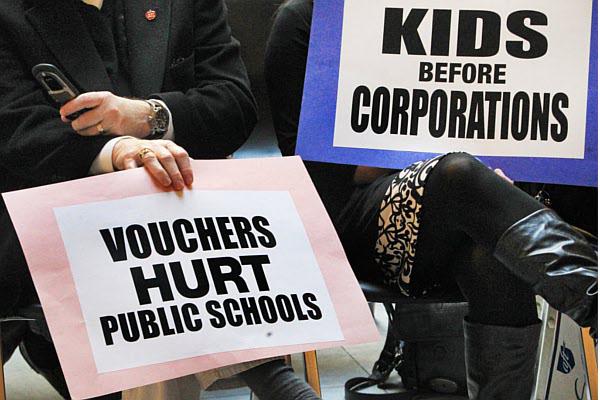Are vouchers costing or saving taxpayer dollars?

A new report by the Democratic-controlled Indiana Department of Education shows the state’s private school voucher program ran a $53 million deficit this year, but school choice advocates dispute that figure and argue that the program is actually saving taxpayer dollars.
Just about everything regarding the cost of the state's voucher program is disputed by one side or the other. But what is not in dispute is its increased popularity. Nearly 33,000 students received a voucher during the 2015-16 school year, making it one of the nation’s largest programs.
However, as those students have increased — thanks, in great part, to lawmakers loosening the eligibility rules — so, too, have the costs. Getting to the bottom of how much, though, depends entirely on who you ask.
The state says the cost for the 2015-16 school year is up from the $40 million deficit the previous year. The deficits reflect a reversal from the program’s first years when fewer students were eligible and the state recouped around $4 million to $5 million in annual savings.
Overall, the state spent $131 million in taxpayer dollars to support sending children to private schools during the most recent school year. An overwhelming majority of those schools are religiously affiliated. The $53 million "deficit" represents the cost to educate students with no record of attending an Indiana public school, according to Samantha Hart, a spokeswoman for the Department of Education.
But that's tricky. The deficit assumes that any voucher student who never attended public school would have otherwise paid to attend private school — and, thus, created no cost to taxpayers. And almost certainly some would have. But no one knows for sure how many others would have simply attended public schools — at taxpayer cost — if no voucher was available.
Robert Enlow, CEO of the Friedman Foundation, which supports vouchers, said the calculation amounts to the department trying to score political points.
“The idea that somehow this program is costing the state money is frankly insane,” Enlow said.
In fact, the voucher program technically came in under budget. For the fiscal year ending in June, lawmakers budgeted $156 million for the program but actually spent $131 million.
School choice advocates have long argued the Department of Education’s "savings/deficit" calculation is deeply flawed, though the Republican-controlled Indiana General Assembly created the formula and initially required the calculation. Beginning in 2015, lawmakers removed the requirement, but Ritz’s agency continues to use the calculation and release its results “to support government transparency,” Hart said.
Supporters of the voucher program have argued the program would ultimately save the state money because vouchers only provide at most 90 percent of the funding a traditional public school would receive on behalf of a student.
“There’s no question that it’s not costing the state what it would cost them if they were in public school,” said Rep. Robert Behning, the Indiana House’s education policy leader. “There is no question about that.”
But the voucher supporters' cost-savings claim also makes a faulty assumption — that all voucher students would otherwise be attending public school. Again, some would attend private school on their own dime at no cost to taxpayers.
The main purpose behind the formula is to calculate the program’s savings. In turn, those savings are supposed to be pumped back in to public schools.
“Since 2013-14, this calculation showed that the program did not result in a savings but instead resulted in a deficit, therefore making a distribution to public schools impossible,” Hart said in an emailed statement.
State Rep. Terri Austin, an Anderson Democrat, said she's struggled with finding a balance of giving parents a choice and the state's decision to spend taxpayer dollars to support private education.
"I do think we're going to have to have some hard conversations about the fiscal cost to the state," Austin said.
The state saw savings with the program in 2011 and 2012 — back when one of the main ways a student could qualify for a voucher required them to spend at least two semesters in a public school. But for the 2013-14 school year, lawmakers increased the number of pathways that allow students to directly enter private schools, including granting eligibility for siblings and students who would have attended an F-rated school.
The assumption has been that many public school students would move to private schools, saving the state money. But much of the increased participation came from students who have never attended a public school. According to state data, more than half of voucher recipients in the 2015-16 school year had no record of attending an Indiana public school.
Call IndyStar reporter Chelsea Schneider at (317) 444-6077. Follow her on Twitter: @IndyStarChelsea.
Are vouchers costing or saving taxpayer dollars?:

